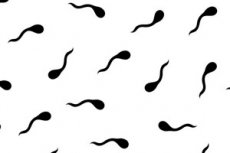New publications
What is the difference between semen and spermatozoa? And can pre-ejaculate cause pregnancy?
Last reviewed: 27.07.2025

All iLive content is medically reviewed or fact checked to ensure as much factual accuracy as possible.
We have strict sourcing guidelines and only link to reputable media sites, academic research institutions and, whenever possible, medically peer reviewed studies. Note that the numbers in parentheses ([1], [2], etc.) are clickable links to these studies.
If you feel that any of our content is inaccurate, out-of-date, or otherwise questionable, please select it and press Ctrl + Enter.

Semen, sperm, ejaculate, pre-ejaculate, seminal fluid. These are just a few of the many words we use to describe what comes out of an erect penis.
Some of these terms can be used interchangeably, but they do not mean the same thing. Do you know the difference?
What are sperm?
Sperm are male reproductive (sex) cells. The word "sperm" can refer to spermatozoon (singular) or spermatozoa (plural).
Sperm are tiny cells with an oval body and a long tail. They are only 1/20 of a millimeter long and can only be seen under a microscope.
They are produced in the two testicles. The testicles are glands located inside the scrotum (the sac of skin below where the penis attaches to the body).
The testicles begin producing sperm during puberty. Sperm production continues throughout adulthood and begins to decline around age 40. The testicles produce about 200 million sperm each day.
Sperm development requires a temperature in the range of 34–35 °C, which is lower than body temperature (usually 36–37 °C). This is why the testicles are located in the cooler scrotum, rather than in the abdomen or pelvis.
Each sperm carries chromosomes, which contain DNA and genes. When a sperm fertilizes a female reproductive cell (egg), their genetic information combines to form an embryo.
What is sperm?
Ejaculated sperm must travel to the fallopian tubes to fertilize the egg. It's a long journey, so the sperm are carried in a fluid that nourishes and protects them (seminal fluid).
Semen is a mixture of spermatozoa and seminal fluid. The word comes from the Latin word “semen,” meaning “seed” (from serere, “to sow”). Semen only exists outside the body, as spermatozoa and seminal fluid only mix at the moment of ejaculation.
Seminal fluid is produced in the sex glands: the seminal vesicles and the prostate gland, which are located behind and below the bladder, respectively.
The seminal vesicles produce a thick, gel-like substance. It sticks the sperm together immediately after ejaculation and provides them with energy (fructose) to survive their journey. The fluid is alkaline, which helps protect the sperm from the acidic environment of the vagina.
The prostate gland produces a thinner, milky fluid containing acids that liquefy the semen. This helps the sperm separate from each other and move through the cervix and uterus to the fallopian tubes. The prostate also supplies the sperm with zinc, which is essential for sperm survival.
During ejaculation, these fluids and sperm are released into the urethra, a narrow tube that runs through the penis and also carries urine. At this point, they combine to form semen.
Semen consists of approximately 10% spermatozoa and 90% fluid from the seminal vesicles and prostate.
What happens after ejaculation?
Typically, between 1.5 and 5 milliliters of semen is released during ejaculation, and each milliliter contains between 15 and 200 million sperm.
If sperm enters the vagina, it must travel about 15 centimeters to reach the fallopian tubes, the most common site of fertilization.
The fastest, healthiest sperm cover this distance (about 3,000 times their body length) in just 30 minutes. For comparison, if an average-sized person swam 3,000 times their body length in the same amount of time, that would be about 5 kilometers (3 miles) in half an hour — twice as fast as the world record for 5 kilometers (3 miles) in open water.
Is there sperm in pre-ejaculate?
During arousal and erection, the penis can release up to 4 ml of pre-ejaculate (pre-semen), which is completely different from sperm.
Pre-ejaculate is produced by other glands, the small bulbourethral glands (Cowper's glands) located beneath the prostate. It is a mucous fluid that lubricates and cleans the urethra in the penis.
In theory, pre-ejaculate does not contain sperm. However, a small study found that about 40% of men had sperm in their pre-ejaculate, although in very small amounts.
The risk of getting pregnant from pre-ejaculate is very low, but not zero.
What can sperm say about health?
Semen is typically creamy white or light gray in color and has a slight ammonia or bleach odor due to the alkaline pH.
However, its color, consistency, and smell may vary from person to person and even from day to day in the same person. If sperm has an unpleasant odor, it may indicate an infection and requires a doctor's consultation.
Contraception and Fertility
Vasectomy is a form of male contraception that involves cutting the two vas deferens that carry sperm from the testicles to the urethra. After a vasectomy, ejaculation still occurs, but the semen is less fluid and does not contain sperm.
Clinical trials of a new male contraceptive - a pill that blocks sperm production in the testicles - have already begun.
Oxidative stress (an imbalance between damaging chemicals and antioxidants) negatively impacts sperm health and significantly contributes to male infertility.
The World Health Organization (WHO) has published normal values for semen volume and sperm count, concentration, motility, and structure in fertile men. However, low sperm count does not always mean decreased fertility.
To maintain healthy sperm, it is recommended:
- a balanced diet rich in antioxidants,
- regular exercise,
- maintaining a healthy weight,
- quitting smoking, drugs and excessive alcohol consumption.
